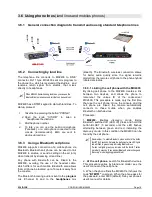
Section 5
Operation at the studios
5.1
Receiving the transmission at the radio station
5.1.1 Incoming signal
The signal arrives to the Studios from the MX2400 in
many ways: as an audio streaming to a standard
computer with Internet access; by cell phone and/or
by land-line via a standard telephone hybrid. We
analyse the case of the console transmitting
streaming over Internet. When streaming link is
used, the signal generated by the MX2400 will
receive duplicate at the studios:
•
a computer with Internet access download
the streaming;
•
a telephonic hybrid receives analogical
audio from land line or cell phone.
This double-link provides a back up signal in case of
losing any of the transmissions, but also cell phone
communication is necessary because the return from
studios to the console is not Internet, but via phone.
Streaming communication is one-way (with the
exception of VoIP that requires an external
computer with VoIP software).
Streaming
:
Pros
•
Allows 'digital' audio quality (20Hz a 15KHz).
•
Allows stereo transmissions.
•
Interferences-free.
Contras
•
Latency.
The signal arrives delayed, due to
the Internet latency. This delay depends on
the connection type and characteristics of
the Internet service in the area. It can be
from 0.3 to 5 seconds.
•
Unidirecional
, from console to Studio.
(except that case of VoIP, but requires an
external computer).
Telephonic signal
:
Pros
•
Without delays.
•
Full duplex.
Contras
•
The audio quality is restricted by telephonic
band –300 to 3.400 Hz– (it can be improved
with VQR® system, but not reach the audio
quality of streaming transmission).
•
Not support stereo transmission.
•
High cost for long distances.
•
Using cell phones, distortion increases and
they are susceptible to interferences.
At the studios, the operator always will prefer to send
on-air the streaming audio, except in the following
cases:
a) If there are problems receiving the streaming
(eg by overloading of the Internet provider's
network).
b) When the delay becomes difficult a fluid
conversation between Studios and the
location.
The first case rarely happens, but if streaming
reception fails (audio choppy or interrupted), the on-
air operator switches the air to the telephone signal,
to continue the transmission from location.
The second case is a dialogue between Location and
Studios. If due to the features of the Internet service
are not achieved low delays in the streaming
transmission, the delay can difficult the conversation,
because the interviewed at the remote console
MX2400 listens the question from Studios, that
reached by phone in real time, but its response
reaches the Studios delayed via Internet. The results
on air are "pauses of silence" between the question
from the Studio speaker and the answer from the
remote location.
In this case, put on-air the audio from the hybrid, with
no delay, instead of streaming.
Remember:
The codec-mixer MX2400 allows both digital stream
and audio by cell phone, so that the Studios make the decision of
which option will be sent to air. For example: using the streaming for
sports and switching to phone link (with lower quality but without
delay) for the interviews at the end of the match.
5.1.2
The streaming path
As seen (3.2 - Transmission over Internet) there are
two ways to operate Internet communications, whether
from a broadband Ethernet connection or a GSM
cellular data network. In either case you can work:
SOLIDYNE
CODEC–MIXER MX2400
Page 25






































